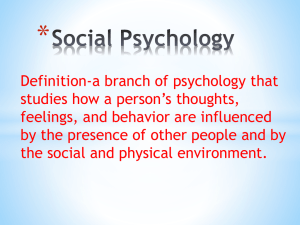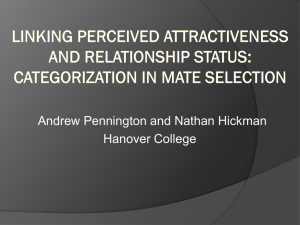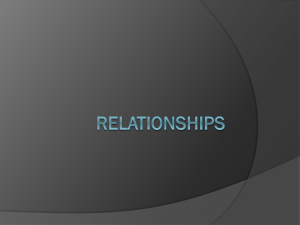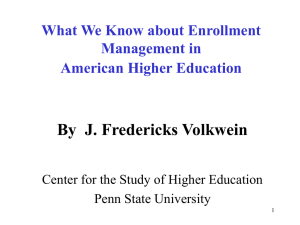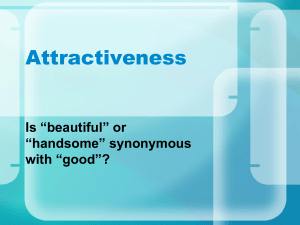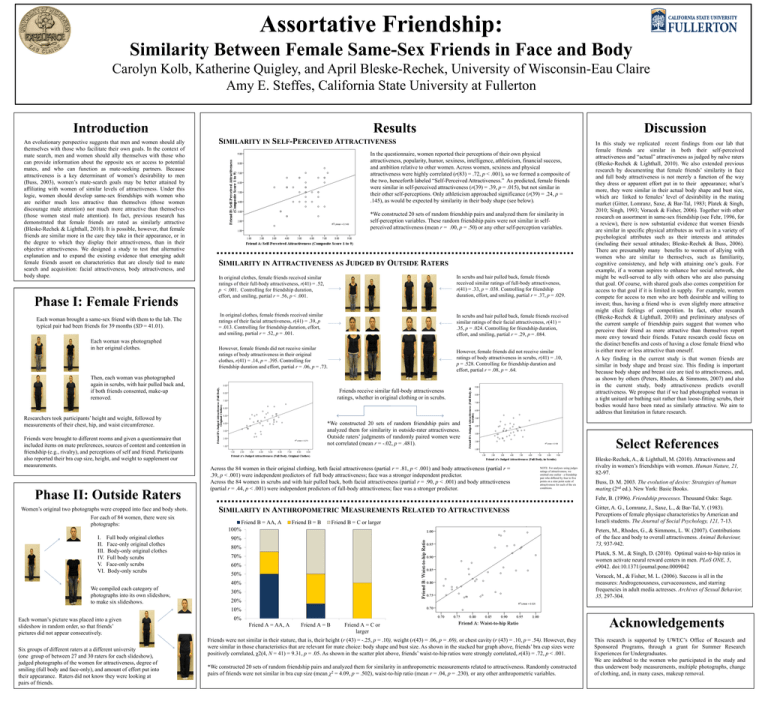
Assortative Friendship:
Similarity Between Female Same-Sex Friends in Face and Body
Carolyn Kolb, Katherine Quigley, and April Bleske-Rechek, University of Wisconsin-Eau Claire
Amy E. Steffes, California State University at Fullerton
Introduction
An evolutionary perspective suggests that men and women should ally
themselves with those who facilitate their own goals. In the context of
mate search, men and women should ally themselves with those who
can provide information about the opposite sex or access to potential
mates, and who can function as mate-seeking partners. Because
attractiveness is a key determinant of women’s desirability to men
(Buss, 2003), women’s mate-search goals may be better attained by
affiliating with women of similar levels of attractiveness. Under this
logic, women should develop same-sex friendships with women who
are neither much less attractive than themselves (those women
discourage male attention) nor much more attractive than themselves
(those women steal male attention). In fact, previous research has
demonstrated that female friends are rated as similarly attractive
(Bleske-Rechek & Lighthall, 2010). It is possible, however, that female
friends are similar more in the care they take in their appearance, or in
the degree to which they display their attractiveness, than in their
objective attractiveness. We designed a study to test that alternative
explanation and to expand the existing evidence that emerging adult
female friends assort on characteristics that are closely tied to mate
search and acquisition: facial attractiveness, body attractiveness, and
body shape.
Phase I: Female Friends
Each woman brought a same-sex friend with them to the lab. The
typical pair had been friends for 39 months (SD = 41.01).
Each woman was photographed
in her original clothes.
Results
SIMILARITY IN SELF-PERCEIVED ATTRACTIVENESS
In the questionnaire, women reported their perceptions of their own physical
attractiveness, popularity, humor, sexiness, intelligence, athleticism, financial success,
and ambition relative to other women. Across women, sexiness and physical
attractiveness were highly correlated (r(83) = .72, p < .001), so we formed a composite of
the two, henceforth labeled “Self-Perceived Attractiveness.” As predicted, female friends
were similar in self-perceived attractiveness (r(39) = .39, p = .015), but not similar in
their other self-perceptions. Only athleticism approached significance (r(39) = .24, p =
.145), as would be expected by similarity in their body shape (see below).
*We constructed 20 sets of random friendship pairs and analyzed them for similarity in
self-perception variables. These random friendship pairs were not similar in selfperceived attractiveness (mean r = .00, p = .50) or any other self-perception variables.
SIMILARITY IN ATTRACTIVENESS AS JUDGED BY OUTSIDE RATERS
In original clothes, female friends received similar
ratings of their full-body attractiveness, r(41) = .52,
p < .001. Controlling for friendship duration,
effort, and smiling, partial r = .56, p < .001.
In scrubs and hair pulled back, female friends
received similar ratings of full-body attractiveness,
r(41) = .33, p = .038. Controlling for friendship
duration, effort, and smiling, partial r = .37, p = .029.
In original clothes, female friends received similar
ratings of their facial attractiveness, r(41) = .39, p
= .013. Controlling for friendship duration, effort,
and smiling, partial r = .52, p = .001.
In scrubs and hair pulled back, female friends received
similar ratings of their facial attractiveness, r(41) =
.35, p = .024. Controlling for friendship duration,
effort, and smiling, partial r = .29, p = .084.
However, female friends did not receive similar
ratings of body attractiveness in their original
clothes, r(41) = .14, p = .395. Controlling for
friendship duration and effort, partial r = .06, p = .73.
Then, each woman was photographed
again in scrubs, with hair pulled back and,
if both friends consented, make-up
removed.
Phase II: Outside Raters
Women’s original two photographs were cropped into face and body shots.
For each of 84 women, there were six
photographs:
I. Full body original clothes
II. Face-only original clothes
III. Body-only original clothes
IV. Full body scrubs
V. Face-only scrubs
VI. Body-only scrubs
However, female friends did not receive similar
ratings of body attractiveness in scrubs, r(41) = .10,
p = .528. Controlling for friendship duration and
effort, partial r = .08, p = .64.
Friends receive similar full-body attractiveness
ratings, whether in original clothing or in scrubs.
Researchers took participants’ height and weight, followed by
measurements of their chest, hip, and waist circumference.
Friends were brought to different rooms and given a questionnaire that
included items on mate preferences, sources of content and contention in
friendship (e.g., rivalry), and perceptions of self and friend. Participants
also reported their bra cup size, height, and weight to supplement our
measurements.
Discussion
*We constructed 20 sets of random friendship pairs and
analyzed them for similarity in outside-rater attractiveness.
Outside raters’ judgments of randomly paired women were
not correlated (mean r = -.02, p = .481).
Across the 84 women in their original clothing, both facial attractiveness (partial r = .81, p < .001) and body attractiveness (partial r =
.39, p < .001) were independent predictors of full body attractiveness; face was a stronger independent predictor.
Across the 84 women in scrubs and with hair pulled back, both facial attractiveness (partial r = .90, p < .001) and body attractiveness
(partial r = .44, p < .001) were independent predictors of full-body attractiveness; face was a stronger predictor.
Select References
NOTE: For analyses using judges
ratings of attractiveness, we
omitted one outlier - a friendship
pair who differed by four to five
points on a nine point scale of
attractiveness for each of the six
conditions.
Bleske-Rechek, A., & Lighthall, M. (2010). Attractiveness and
rivalry in women’s friendships with women. Human Nature, 21,
82-97.
Buss, D. M. 2003. The evolution of desire: Strategies of human
mating (2nd ed.). New York: Basic Books.
Fehr, B. (1996). Friendship processes. Thousand Oaks: Sage.
SIMILARITY IN ANTHROPOMETRIC MEASUREMENTS RELATED TO ATTRACTIVENESS
Friend B = AA, A
100%
Friend B = B
Friend B = C or larger
Gitter, A. G., Lomranz, J., Saxe, L., & Bar-Tal, Y. (1983).
Perceptions of female physique characteristics by American and
Israeli students. The Journal of Social Psychology, 121, 7-13.
Peters, M., Rhodes, G., & Simmons, L. W. (2007). Contributions
of the face and body to overall attractiveness. Animal Behaviour,
73, 937-942.
90%
80%
Platek, S. M., & Singh, D. (2010). Optimal waist-to-hip ratios in
women activate neural reward centers in men. PLoS ONE, 5,
e9042. doi:10.1371/journal.pone.0009042
70%
60%
50%
Voracek, M., & Fisher, M. L. (2006). Success is all in the
measures: Androgenousness, curvaceousness, and starring
frequencies in adult media actresses. Archives of Sexual Behavior,
35, 297-304.
40%
We compiled each category of
photographs into its own slideshow,
to make six slideshows.
In this study we replicated recent findings from our lab that
female friends are similar in both their self-perceived
attractiveness and “actual” attractiveness as judged by naïve raters
(Bleske-Rechek & Lighthall, 2010). We also extended previous
research by documenting that female friends’ similarity in face
and full body attractiveness is not merely a function of the way
they dress or apparent effort put in to their appearance; what’s
more, they were similar in their actual body shape and bust size,
which are linked to females’ level of desirability in the mating
market (Gitter, Lomranz, Saxe, & Bar-Tal, 1983; Platek & Singh,
2010; Singh, 1993; Voracek & Fisher, 2006). Together with other
research on assortment in same-sex friendship (see Fehr, 1996, for
a review), there is now substantial evidence that women friends
are similar in specific physical attributes as well as in a variety of
psychological attributes such as their interests and attitudes
(including their sexual attitudes; Bleske-Rechek & Buss, 2006).
There are presumably many benefits to women of allying with
women who are similar to themselves, such as familiarity,
cognitive consistency, and help with attaining one’s goals. For
example, if a woman aspires to enhance her social network, she
might be well-served to ally with others who are also pursuing
that goal. Of course, with shared goals also comes competition for
access to that goal if it is limited in supply. For example, women
compete for access to men who are both desirable and willing to
invest; thus, having a friend who is even slightly more attractive
might elicit feelings of competition. In fact, other research
(Bleske-Rechek & Lighthall, 2010) and preliminary analyses of
the current sample of friendship pairs suggest that women who
perceive their friend as more attractive than themselves report
more envy toward their friends. Future research could focus on
the distinct benefits and costs of having a close female friend who
is either more or less attractive than oneself.
A key finding in the current study is that women friends are
similar in body shape and breast size. This finding is important
because body shape and breast size are tied to attractiveness, and,
as shown by others (Peters, Rhodes, & Simmons, 2007) and also
in the current study, body attractiveness predicts overall
attractiveness. We propose that if we had photographed woman in
a tight unitard or bathing suit rather than loose-fitting scrubs, their
bodies would have been rated as similarly attractive. We aim to
address that limitation in future research.
30%
20%
10%
Each woman’s picture was placed into a given
slideshow in random order, so that friends’
pictures did not appear consecutively.
Six groups of different raters at a different university
(one group of between 27 and 30 raters for each slideshow),
judged photographs of the women for attractiveness, degree of
smiling (full body and face-only), and amount of effort put into
their appearance. Raters did not know they were looking at
pairs of friends.
0%
Friend A = AA, A
Friend A = B
Friend A = C or
larger
Friends were not similar in their stature, that is, their height (r (43) = -.25, p = .10), weight (r(43) = .06, p = .69), or chest cavity (r (43) = .10, p = .54). However, they
were similar in those characteristics that are relevant for mate choice: body shape and bust size. As shown in the stacked bar graph above, friends’ bra cup sizes were
positively correlated, χ2(4, N = 41) = 9.31, p = .05. As shown in the scatter plot above, friends’ waist-to-hip ratios were strongly correlated, r(43) = .72, p < .001.
*We constructed 20 sets of random friendship pairs and analyzed them for similarity in anthropometric measurements related to attractiveness. Randomly constructed
pairs of friends were not similar in bra cup size (mean χ2 = 4.09, p = .502), waist-to-hip ratio (mean r = .04, p = .230), or any other anthropometric variables.
Acknowledgements
This research is supported by UWEC’s Office of Research and
Sponsored Programs, through a grant for Summer Research
Experiences for Undergraduates.
We are indebted to the women who participated in the study and
thus underwent body measurements, multiple photographs, change
of clothing, and, in many cases, makeup removal.

